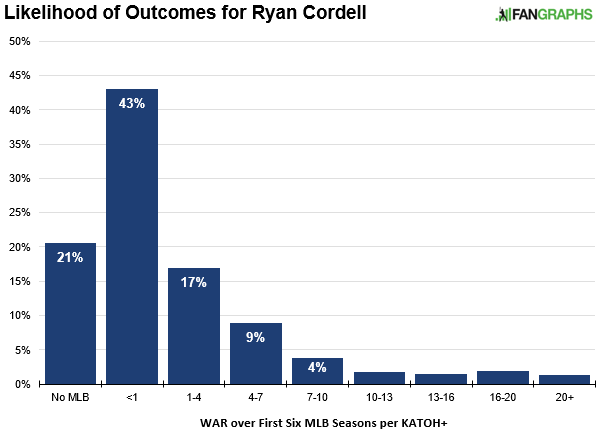Projecting Brewers Acquisition Ryan Cordell
Back at the trade deadline, the Milwaukee Brewers dealt Jonathan Lucroy and Jeremy Jeffress to the Texas Rangers in exchange for prospects Lewis Brinson and Luis Ortiz, along with a player-to-be-named-later. That player now has a name, and it’s Ryan Cordell. Cordell spent all of 2016 playing at the Double-A level, where he slashed a solid .264/.319/.484 with 19 homers and 12 steals. He produced a similar batting line last year, though it was split up between a dominant performance at High-A and an underwhelming showing at Double-A.
Cordell doesn’t have any one skill to separate him from the crowd offensively, but he doesn’t have any massive weaknesses either. He hits for decent power, doesn’t strikeout terribly often and provides some value on the bases. Defensively, he grades out as well above average in the outfield, with the plurality of his games coming in center. Altogether, that makes for a promising young player.
KATOH pegs Cordell for 4.7 WAR over his first six seasons by the traditional method and 3.8 WAR by KATOH+, which integrates Baseball America’s rankings. Cordell ranked 77th on KATOH’s mid-season top-100 list, which to my knowledge, is the only top-100 list he’s come anywhere close to cracking. To help you visualize what his KATOH projection entails, here is a probability density function showing KATOH+’s projected distribution of outcomes for Cordell’s first six seasons in the major leagues.

To put some faces to Cordell’s statistical profile, let’s generate some statistical comps for the newest Brewers prospect. I calculated a weighted Mahalanobis distance between Cordell’s performance this year and every Double-A season since 1991 in which an outfielder recorded at least 400 plate appearances. In the table below, you’ll find the 10 most similar seasons, ranked from most to least similar. The WAR totals refer to each player’s first six seasons in the major leagues. A lower “Mah Dist” reading indicates a closer comp.
Please note that the Mahalanobis analysis is separate from KATOH. KATOH relies on macro-level trends, rather than comps. The fates of a few statistically similar players shouldn’t be used to draw sweeping conclusions about a prospect’s future. For this reason, I recommend using a player’s KATOH forecast to assess his future potential. The comps give us some interesting names that sometimes feel spot-on, but they’re mostly just there for fun.
| Rank | Name | Mah Dist | KATOH+ Proj. WAR | Actual WAR |
| 1 | Alexis Gomez | 0.77 | 3.0 | 0.3 |
| 2 | Dan Ortmeier | 0.94 | 2.2 | 0.3 |
| 3 | Nolan Reimold | 1.23 | 2.9 | 3.4 |
| 4 | Brandon Jones | 1.70 | 4.9 | 0.1 |
| 5 | Mark Quinn | 1.75 | 2.7 | 2.6 |
| 6 | Mario Encarnacion | 1.76 | 2.2 | 0.0 |
| 7 | Angel Echevarria | 1.94 | 2.7 | 0.5 |
| 8 | Brandon Boggs | 2.00 | 3.0 | 1.1 |
| 9 | Stephen Smitherman | 2.07 | 2.9 | 0.0 |
| 10 | Aaron Rowand | 2.08 | 3.0 | 19.6 |
The Brewers have been hoarding prospects over the past year or so, and have acquired several KATOH guys — youngsters who are absent from traditional prospect lists, but have caught KATOH’s eye by performing well in the minors. Some of those acquisitions have already turned into useful big leaguers. Jonathan Villar, Keon Broxton and Zach Davies are the most noteworthy examples. The Cordell acquisition fits the Brewer’s M.O. to a T. Though he’s produced little more than a blip on the prospect radar, don’t be surprised to see Cordell is producing for Milwaukee a year from now.
Chris works in economic development by day, but spends most of his nights thinking about baseball. He writes for Pinstripe Pundits, FanGraphs and The Hardball Times. He's also on the twitter machine: @_chris_mitchell None of the views expressed in his articles reflect those of his daytime employer.
I really enjoy these. thanks,